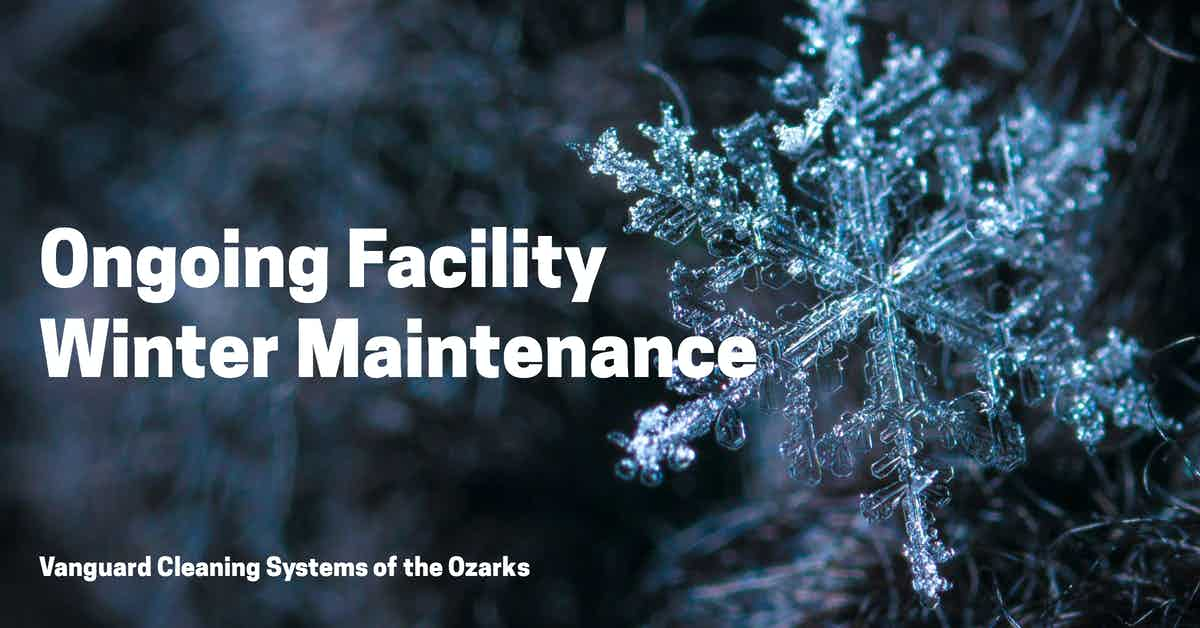Intense winter storms and advisories across much of the Mid-Western United States underscore the importance of maintaining winter facility cleaning and maintenance protocols to prevent costly structural damage and the transmission of deadly pathogens now and into the Spring.

Keeping Up With Winter Maintenance
For many across the Mid-Western US, the winter has been long and challenging, often resulting in fatigue that drives some to avoid complex but critical maintenance tasks.
However, mid-season checks on winter maintenance will significantly impact facility and occupant safety and hygiene for months to come.
Essential tasks and checks to make during this phase include:
- Draining the sprinkler system to prevent pipes from freezing and rupturing.
- Removing snow from the roof before it reaches six inches in height to prevent structural damage.
- Sweeping snow buildup off walkways and away from downspouts, facility exits, and building foundations.
- Allowing faucets to drip (slightly) to prevent them from freezing and rupturing.
- Performing HVAC, furnace, and duct inspections, maintenance, and repairs.
- Checking and clearing rain gutters and downspouts to ensure snowmelt is not obstructed and that water moves away from the foundation of the building, and;
- Keeping up with floor maintenance to protect the facility's built environment, prevent slips, trips, and falls, and disrupt the transmission of deadly pathogens.
Floor Maintenance Prevents the Transmission of Pathogens
Facility flooring is an overlooked and under-addressed reservoir for pathogens and pathogenic bacteria.
This is due, in part, to guidelines by the US Centers for Disease Control and Prevention that classified floors as non-critical in infection prevention, which is traditionally focused on more conventional high-touch surface disinfection.
However, a 2017 study forced the CDC to reconsider its position and guidelines regarding facility flooring's role in the chain of infection.
According to the results of the study, originally posted to The American Journal of Infection Control;
These results suggest that floors in hospital rooms could be an underappreciated source for the dissemination of pathogens.
It would be reasonable to educate health care personnel and patients that they should avoid placing high-touch objects on the floor when possible.
Moreover, the efficacy of current floor-cleaning and disinfection techniques should be reexamined, particularly with regard to eliminating C. difficile spores.
Respiratory Droplets and Floor Care
The term respiratory droplets achieved a significant level of notoriety during the SARS-CoV-2 pandemic as the primary route of transmission of the COVID-19 infection.
Contaminated respiratory droplets are typically expelled from an infected host through one of four routes:
- Breathing.
- Talking.
- Sneezing, and;
- Coughing.
The droplets are then aerosolized and can travel approximately six feet before descending to nearby surfaces, including floors.
From there, the droplets can travel a significant distance via:
- Airflow from windows, HVAC systems, or people walking by.
- Occupant shoes, or;
- Contaminated mops and mop water (cross-contamination).
While airborne and traveling, the disrupted contaminated droplets can infect occupants via respiratory (inhalation) transmission.
Eventually, however, the droplets will resettle on various surfaces, including the floor, where they are contacted and spread to occupants via dermal (touch) transmission.
Floor Care as Part of a Wholistic Cleaning Process
Ongoing high-quality floor care is a critical component of enhanced clean for health protocols.
High-traffic walkways should be considered as one of the most commonly touched surfaces in a facility and treated by maintenance and service personnel accordingly, and, as such:
- Facility floors should be swept, dusted, mopped, or vacuumed daily.
- Walkway and entry matting should be placed along high-traffic areas to capture soil and pathogens and prevent their transmission to other parts of the facility.
- Walkway and entry matting should be maintained and cared for according to manufacturer guidelines.
- Proper cleaning and disinfectant product selection is crucial to kill viruses and bacteria while protecting the built environment.
- Service providers must be proficient in cross-contamination prevention through ongoing training and proper tool provisioning, and;
- Floors--hard surface or carpeting--should be deep routinely deep cleaned according to manufacturer guidelines to prevent premature wear and tear or contaminant buildup.
References & Resources
Takeaway
Ongoing floor care, in addition to addressing a major pathogen reservoir and route for infection transmission, is mandatory for keeping up with mid-winter facility maintenance and upkeep tasks.
To achieve maximum efficacy, service providers must be trained and proficient in cross-contamination prevention, or the spread of infection is not only likely but it should also be considered an increased risk.
Outsourcing cleaning and maintenance services is a proven and cost-effective measure for protecting the built environment of commercial facilities as well as the health and safety of its occupants.
Contact us today and discover why Vanguard Cleaning Systems® is the Standard of Clean® for businesses throughout Northwest Arkansas, Missouri, and Oklahoma.
In Oklahoma, dial 918-960-4450
In Arkansas, dial 479-717-2410
In Missouri, dial 417-812-9777
